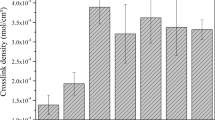Abstract
Hybrid carbon black (CB) and nanoclay (NC) in a rubber matrix have provided superior mechanical performances over conventional composites. Yet the fracture and fatigue properties have not been fully explored. In this paper, the mechanical properties of the hybrid-filled natural rubber (NR) were investigated with regard to the tensile strength, fatigue crack growth (FCG) and cut resistance. The ruptured crack tip and the torn surface were studied by using optical microscopy and scanning electron microscopy (SEM), respectively. It was found that the fatigue resistance at large tearing energy and cut strength were enhanced with hybrid filler. Subsidiary cracks were observed at the ruptured tip in rubber with NC. Morphology analysis revealed that the hybrid filler led to a rougher torn surface than rubber with non-hybrid filler. It was proposed that the clay layers constructed a dual phase filler network with CB aggregates. The filler network could cause strength anisotropy in the matrix and introduce more energy dissipation mechanisms to the system, resulting in enhanced fatigue resistance.






Similar content being viewed by others
References
Mars WV, Fatemi A (2002) Int J Fatigue 24:949–961
Wu YP, Zhao W, Zhang LQ (2006) Macromol Mater Eng 291:944–949
Hamed GR (2000) Rubber Chem Technol 73:524–533
Hamed GR, Al-Sheneper AA (2003) Rubber Chem Technol 76:436
EIIuI MD (2001) Engineering with rubber-how to design rubber components. In: Gent AN (ed), 2nd edn. Hanser, Munich.
Mars WV, Fatemi A (2004) Rubber Chem Technol 77:391–412
Kluppel M (2009) Macromol Mater Eng 294:130–140
Reincke K, Grellmann W, Kluppel M (2009) Kautsch Gummi Kunstst 62:246–251
Persson BNJ, Albohr O, Heinrich G, Ueba H (2005) J Phys-Condens Mat 17:R1071–R1142
Arroyo M, Lopez-Manchado MA, Herrero B (2003) Polymer 44:2447–2453
Carretero-Gonzalez J, Verdejo R, Toki S, Hsiao BS, Giannelis EP, Lopez-Manchado MA (2008) Macromolecules 41:2295–2298
Al-Yamani F, Goettler LA (2007) Rubber Chem Technol 80:100–114
Bala P, Samantaray BK, Srivastava SK, Nando GB (2004) J Appl Polym Sci 92:3583–3592
Joly S, Garnaud G, Ollitrault R, Bokobza L, Mark JE (2002) Chem Mat 14:4202–4208
Munusamy Y, Ismail H, Mariatti M, Ratnam CT (2008) J Reinf Plast Compos 27:1925–1945
Jia QX, Wu YP, Xiang P, Ye X, Wang YQ, Zhang LQ (2005) Polym Polym Compos 13:709–719
Praveen S, Chattopadhyay PK, Albert P, Dalvi VG, Chakraborty BC, Chattopadhyay S (2009) Compos Pt A-Appl Sci Manuf 40:309–316
Chattopadhyay PK, Basuli U, Chattopadhyay S (2009) Polym Compos. doi:10.1002/pc.20866
Maiti M, Sadhu S, Bhowmick AK (2005) J Appl Polym Sci 96:443–451
Lorenz H, Fritzsche J, Das A, Stockelhuber KW, Jurk R, Heinrich G, Kluppel M (2009) Compos Sci Technol 69:2135–2143
Jin J, Chen L, Song M, Yao KJ (2006) Macromol Mater Eng 291:1414–1421
Song M, Wong CW, Jin J, Ansarifar A, Zhang ZY, Richardson M (2005) Polym Int 54:560–568
Arroyo M, Lopez-Manchado MA, Valentin JL, Carretero J (2007) Compos Sci Technol 67:1330–1339
Lietz S, Sandler JKW, Bosch E, Altstadt V (2006) Kautsch Gummi Kunstst 59:388–395
Mazich KA, Samus MA, Smith CA, Rossi G (1991) Macromolecules 24:2766–2769
Griffith AA (1921) Philos Trans R Soc London. Ser A 221:163–198
Rivlin RS, Thomas AG (1953) J Polym Sci 10:291–318
Thomas AG (1962) Rheologica Acta 2:63–66
Greensmith HW, Mullins L, Thomas AG (1960) J Rheol 4:179–189
Lake GJ, Thomas AG (1967) Proc R Soc London. Ser A 300:108–119
Qu LL, Huang GS, Liu ZY, Zhang P, Weng GS, Nie YJ (2009) Acta Mater 57:5053–5060
Carretero-Gonzalez J, Retsos H, Verdejo R, Toki S, Hsiao BS, Giannelis EP, Lopez-Manchado MA (2008) Macromolecules 41:6763–6772
Hamed GR, Park BH (1999) Rubber Chem Technol 72:946–959
Busse WF (1934) Ind Eng Chem 26:1194–1199
Hamed GR (2005) Rubber Chem Technol 78:548–553
Gent AN, Razzaghi-Kashani A, Hamed GR (2003) Rubber Chem Technol 76:122–131
Gent AN, Pulford CTR (1984) J Mater Sci 19:3612–3619
Kaang S, Nah C (1998) Polymer 39:2209–2214
Acknowledgements
The financial support from the National Basic Research Program of China (No. 2007CB714700) is greatly appreciated. The authors acknowledge the support of the Maryland NanoCenter and its NispLab. The NispLab is supported in part by the NSF as a MRSEC Shared Experimental Facility.
Author information
Authors and Affiliations
Corresponding author
Rights and permissions
About this article
Cite this article
Liu, Y., Li, L., Wang, Q. et al. Fracture properties of natural rubber filled with hybrid carbon black/nanoclay. J Polym Res 18, 859–867 (2011). https://doi.org/10.1007/s10965-010-9482-5
Received:
Accepted:
Published:
Issue Date:
DOI: https://doi.org/10.1007/s10965-010-9482-5




